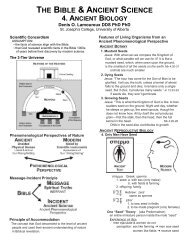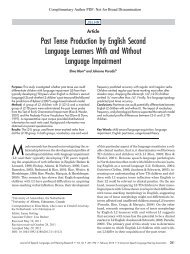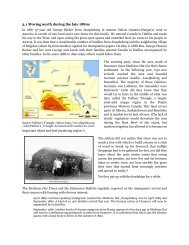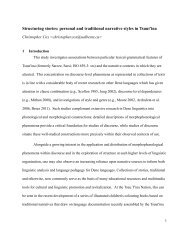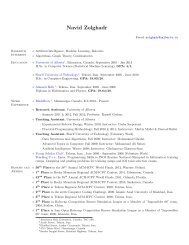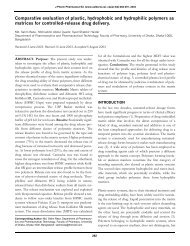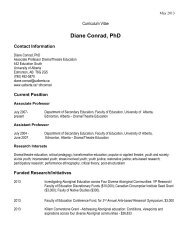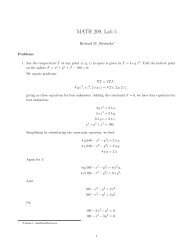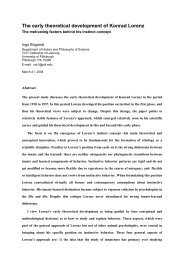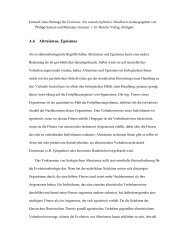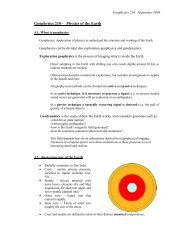Processing of Primary Fischer-Tropsch Products - University of Alberta
Processing of Primary Fischer-Tropsch Products - University of Alberta
Processing of Primary Fischer-Tropsch Products - University of Alberta
You also want an ePaper? Increase the reach of your titles
YUMPU automatically turns print PDFs into web optimized ePapers that Google loves.
Figure 2 Current (2004) High Temperature <strong>Fischer</strong>-<strong>Tropsch</strong> refinery used at Secunda<br />
The HTFT reactors at Sasol 1 were decommissioned in the 1990's and the<br />
facility was converted to a chemicals production site. The Secunda plants also<br />
started to lose their identity as fuels-only refineries as more and more chemicals<br />
were targeted for extraction [12]. Yet, most <strong>of</strong> the production volume still went<br />
to fuels and with the more stringent fuel specifications, some fuels refining units<br />
were added, such as etherification and skeletal isomerisation (Fig. 2).<br />
With the construction <strong>of</strong> the first commercial HTFT gas-to-liquids (GTL)<br />
plant, an all-fuels approach was again followed. The PetroSA GTL plant started<br />
operation in 1993 as Mossgas in Mossel Bay, South Africa. The plant is an<br />
integrated facility for natural gas processing that makes use <strong>of</strong> Sasol Synthol<br />
technology. The feed is obtained from their own natural gas fields located<br />
<strong>of</strong>fshore. The primary gas separation is done at the main production platform<br />
where Raw Natural Gas and Natural Gas Liquids (NGL) are produced and<br />
transported some 120 km to the GTL plant by pipelines. A secondary separation<br />
is done onshore where the natural gas composition is made compatible with the<br />
GTL process requirements and the NGL is separated into Liquefied Petroleum<br />
Gas (LPG), Naphtha and Diesel. The refinery design resembled that <strong>of</strong> the<br />
Secunda facilities, but some changes were made to the C2-C8 processing (Fig. 3)<br />
[13].<br />
Condensate<br />
Gas<br />
Natural<br />
Gas<br />
Liquids<br />
Recovery<br />
T"<br />
<strong>Fischer</strong>-<br />
<strong>Tropsch</strong><br />
process<br />
........................... ~ Skeletal isomerisation I 9<br />
iiiiii ! ili- ,I Alkylation ] ~ Alkylatepetrol<br />
Tail !i 9 LPG<br />
gas ! i _ _ ~ O lefin oligomerisation I 9 Unhydrogenated petrol<br />
llr<br />
i. ~ s keletal isom e ris a t ion [ I ~ Isomerate petrol<br />
i ~j Naphtha hydrogenation [<br />
Light [ S0111 "11 t ]i~i a b i l i s<br />
9 " "-i I<br />
..,<br />
"[ e Naphtha d ref~<br />
i -~ LPG<br />
-~ Aromatic petrol<br />
9 :_1 Distillate hydrogenation I -~ Kerosene<br />
Decanted k.U/ , "-~ A -~ Diesel<br />
Oil | '~ ...................................................................... i<br />
| L Fuel oil<br />
Aqueous product "l Chemical work-up [ -~'~ WaterOXygenate chemicals<br />
Figure 3 High Temperature <strong>Fischer</strong>-<strong>Tropsch</strong> refinery design <strong>of</strong> Mossgas (now PetroSA) at<br />
Mossel Bay<br />
485



